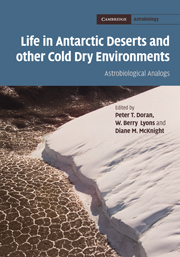Book contents
- Frontmatter
- Contents
- List of contributors
- 1 Introduction
- 2 Geologic analogies between the surface of Mars and the McMurdo Dry Valleys: microclimate-related geomorphic features and evidence for climate change
- 3 The legacy of aqueous environments on soils of the McMurdo Dry Valleys: contexts for future exploration of martian soils
- 4 The antarctic cryptoendolithic microbial ecosystem
- 5 Antarctic McMurdo Dry Valley stream ecosystems as analog to fluvial systems on Mars
- 6 Saline lakes and ponds in the McMurdo Dry Valleys: ecological analogs to martian paleolake environments
- 7 The biogeochemistry and hydrology of McMurdo Dry Valley glaciers: is there life on martian ice now?
- 8 Factors promoting microbial diversity in the McMurdo Dry Valleys, Antarctica
- 9 Other analogs to Mars: high-altitude, subsurface, desert, and polar environments
- Index
- References
9 - Other analogs to Mars: high-altitude, subsurface, desert, and polar environments
Published online by Cambridge University Press: 06 July 2010
- Frontmatter
- Contents
- List of contributors
- 1 Introduction
- 2 Geologic analogies between the surface of Mars and the McMurdo Dry Valleys: microclimate-related geomorphic features and evidence for climate change
- 3 The legacy of aqueous environments on soils of the McMurdo Dry Valleys: contexts for future exploration of martian soils
- 4 The antarctic cryptoendolithic microbial ecosystem
- 5 Antarctic McMurdo Dry Valley stream ecosystems as analog to fluvial systems on Mars
- 6 Saline lakes and ponds in the McMurdo Dry Valleys: ecological analogs to martian paleolake environments
- 7 The biogeochemistry and hydrology of McMurdo Dry Valley glaciers: is there life on martian ice now?
- 8 Factors promoting microbial diversity in the McMurdo Dry Valleys, Antarctica
- 9 Other analogs to Mars: high-altitude, subsurface, desert, and polar environments
- Index
- References
Summary
Abstract
The McMurdo Dry Valleys detailed in previous chapters represent one environment for life thought to have existed on Mars among many. This chapter illustrates other potential habitats and their significance: (1) high-altitude lakes subjected to rapid climate change in the Andes provide analogy to the Noachian/Hesperian transition on Mars; (2) Río Tinto, Spain, where conditions are reminiscent of Meridiani Planum, unravels an underground anaerobic chemoautotroph biosphere that could resemble a modern refuge for life on Mars; (3) the High Arctic hosts gullies analogous to those observed on Mars, whose fresh deposits could provide access to traces of past and/or present underground oases; it is also in this polar environment that the Haughton-Mars Project helps answer long-standing questions, revisiting classical assumptions, and sometimes reshaping our thinking on many issues in planetary science and astrobiology, in particular in relation to Mars; (4) the search for microbial life in the arid soils of the Atacama desert and its robotic detection characterize what role aridity plays in the distribution of life and how to search for evidence of rare and scattered biosignatures.
Introduction
Because of its geology and climate evolution, Mars is likely to have developed a diversity of potential habitats for life over time. The main ingredients for habitability (i.e., water, energy, and nutrients) were present early, as demonstrated by the Spirit and Opportunity rovers at Gusev crater and Meridiani Planum (Knoll et al., 2005; Des Marais et al.,2005, 2008).
- Type
- Chapter
- Information
- Life in Antarctic Deserts and other Cold Dry EnvironmentsAstrobiological Analogs, pp. 258 - 305Publisher: Cambridge University PressPrint publication year: 2010

